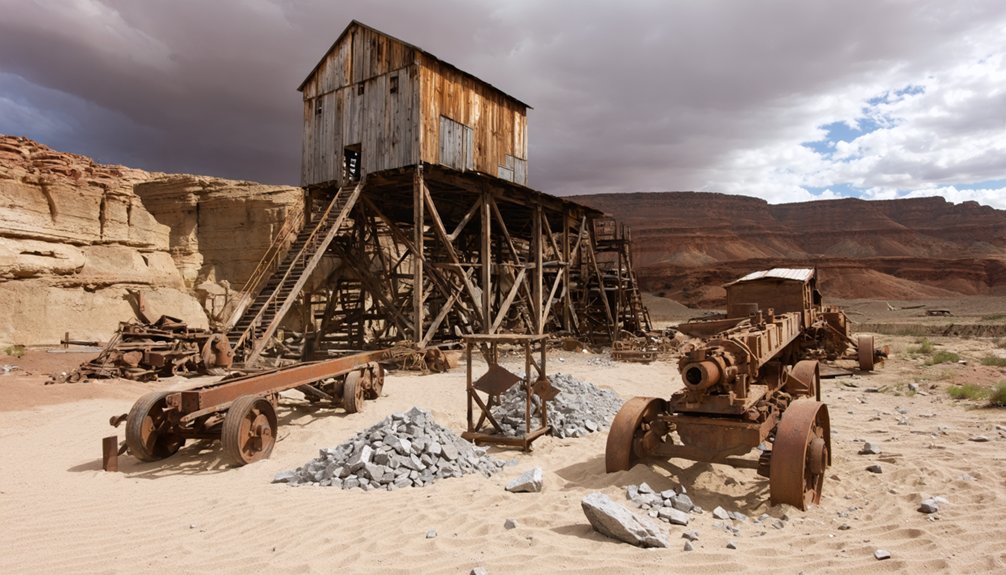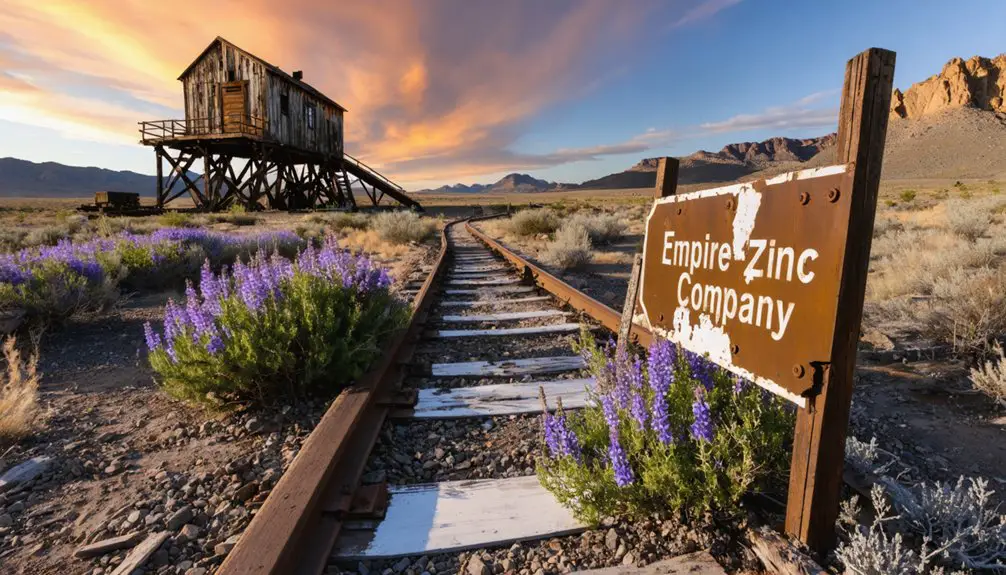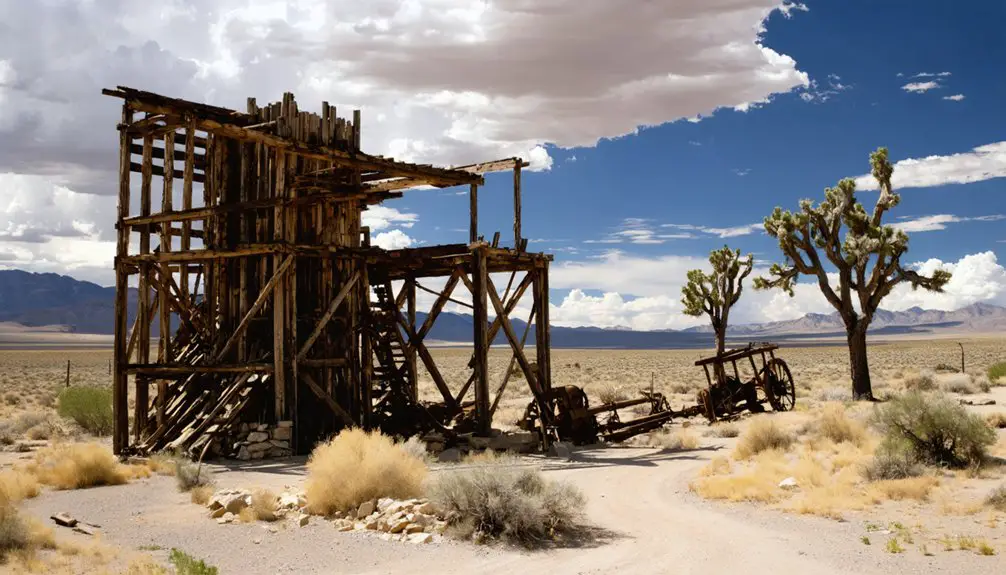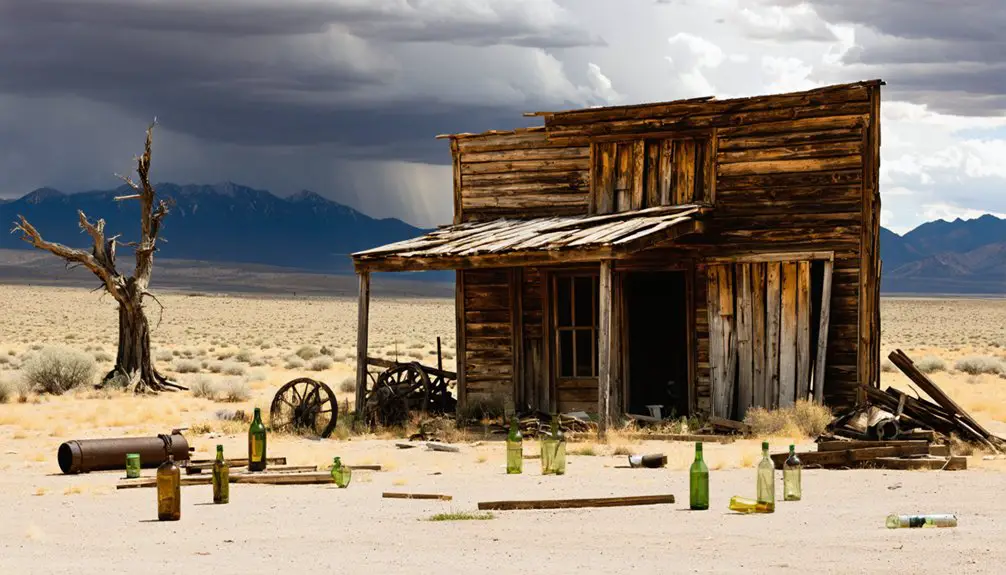You’ll find Potosi, Nevada’s first major mining discovery, nestled at the base of 8,517-foot Potosi Mountain, 30 miles southwest of Las Vegas. Mormon settlers established the site in 1856, constructing the first smelter west of the Missouri River for lead extraction. Though initially abandoned in 1857 due to challenging ore composition, the site later transformed into Nevada’s largest zinc producer during World War I. The ghost town’s ruins and mountain trails reveal centuries of mining evolution and technological adaptation.
Key Takeaways
- Potosi is Nevada’s first major mining discovery and abandoned mining operation, established by Mormon settlers in 1856 for lead extraction.
- Located 30 miles southwest of Las Vegas in the Spring Mountains, Potosi sits at the base of 8,517-foot Potosi Mountain.
- The mining camp housed 100 residents by 1861 and later became Nevada’s largest zinc producer during World War I.
- Mining operations faced challenges including high zinc content in lead ore, water scarcity, and difficult transportation across rugged terrain.
- Access requires navigating dirt roads off Highway 160 between Las Vegas and Pahrump, with some routes requiring 4WD vehicles.
The Mormon Origins: First Settlement in 1856
Three key events marked the Mormon settlement of Potosi in 1856: a Paiute guide’s discovery of lead deposits, Brigham Young’s strategic dispatch of Nathaniel V. Jones, and the establishment of mining operations.
You’ll find that Mormon motivations centered on achieving economic independence through local resource development, leading them to embrace Paiute guidance in locating valuable mineral deposits. The site, positioned 30-35 miles southwest of the Las Vegas Mission, represented one of the earliest Mormon prospecting ventures in southern Nevada. The settlers quickly constructed a furnace for smelting by September, though mining operations would face significant challenges in the months ahead. The initial mining effort yielded approximately 9,000 pounds of lead before the site was abandoned in early 1857.
From Lead Mining to Ghost Town
You’ll find evidence of the earliest lead mining challenges at Potosi in the remains of the crude smelter where Mormon settlers processed 9,000 pounds of ore before abandoning their efforts in 1857.
The high zinc and silver content in the lead ore proved too problematic for bullet production, making the mine Nevada’s first officially abandoned operation.
What followed was a series of sporadic mining ventures spanning from 1861 to 1930, including the Colorado Mining Company’s silver operations, the Silver State Mining Company’s Crystal City period, and finally the Empire Zinc Company’s peak production years that ended shortly after World War I. During WWI, the mine was designated as a priority defense project and produced approximately 30,000 tons of zinc per year.
The arrival of the San Pedro Railroad in 1906 brought new life to Potosi’s operations, making ore transportation more efficient and economical.
Mormon Smelting Challenges
The Mormon colonists’ ambitious smelting operation at Potosi faced immediate technical and logistical hurdles in 1855, when they constructed the first smelter west of the Missouri River inside the Las Vegas stockade walls.
Their initial smelting techniques proved inadequate when furnace materials couldn’t withstand the intense blast. Though they rebuilt with improved materials by Christmas 1856, other challenges emerged. You’d have found the ore’s high zinc and silver content made it too brittle for bullets, severely impacting economic viability.
The remote location, 30 miles from Las Vegas Springs, complicated matters further. While wood was plentiful, water sources lay 12 miles away. The mine was later reactivated when the San Pedro Railroad arrived in 1905.
Despite establishing the Old Mormon Camp as a rest stop, the arduous task of transporting ore by oxen and burros proved unsustainable. By January 1857, they’d recovered just 9,000 pounds before abandoning the operation.
Mining Operations Timeline
Mining activity at Potosi began well before official records, as evidence suggests Mexican miners worked the area’s rich deposits as early as the 1830s, with Native Americans possibly extracting ore even earlier.
You’ll find the first documented mining techniques emerged in 1856 when Mormon settlers, led by Nathaniel V. Jones, established primitive smelting operations. Despite early setbacks due to zinc content complications, the site saw multiple revivals.
The 1861 California interests brought advanced ore analysis capabilities, followed by the Silver State Mining Company‘s operations in 1870. The real transformation came with Empire Zinc Company‘s 1913 takeover, introducing modern equipment including aerial tramways and electrical systems.
The Return of Mining Activity in 1861
After lying dormant for four years, Potosi’s rich mineral deposits caught the attention of California mining interests in 1861, sparking a significant revival of operations at Nevada’s first lode mine.
The mining revival brought improved smelting technology, including a large smelter constructed at Potosi Spring to tackle the challenging zinc-rich ore that had defeated earlier attempts.
You’ll find evidence of this period in the remains of rock cabins that once housed 100 miners after the Colorado Mining Company established the Potosi townsite.
Though the operation lasted barely two years, closing before the end of 1863, it marked a vital shift from pioneer mining to industrial-scale operations.
The site’s development laid the foundation for future mining endeavors, despite ongoing challenges with ore processing and remote location.
The area would later become crucial during World War I as it supplied significant amounts of zinc for the war effort.
Location and Geography in the Spring Mountains
If you’re approaching Potosi from Las Vegas, you’ll find this ghost town nestled in the Spring Mountains approximately 30 miles southwest, at the base of Potosi Mountain’s 8,517-foot peak.
The mountain’s distinctive limestone terrain features steep cliffs on its northern and eastern faces, while its southern slopes offer gentler gradients through piñon pine and juniper forests. The area provides scenic panoramic views of surrounding landmarks including Rainbow Mountains, Mt. Charleston Wilderness, and Charleston Peak.
Access requires traversing dirt and gravel roads, with some routes demanding 4WD vehicles due to rough terrain and gated maintenance paths leading to the three summit areas where communication towers now stand. Today, these towers serve as a vital major FM broadcast site for the Las Vegas metropolitan area.
Mountain Range Terrain Features
The Spring Mountains showcase dramatic geological formations shaped by ancient seabeds that were folded, faulted, and uplifted over millions of years.
You’ll find towering limestone and dolomite cliffs that dominate the rugged terrain, with deep canyons carved through the range by centuries of water erosion. These geological formations create a stark contrast between the desert below and mountain peaks above. The area between Pahrump and Las Vegas contains some of the most diverse ecosystems.
The porous nature of the rock has given birth to over 100 natural springs, creating unexpected oases throughout the range. The dramatic elevations reach up to 11,918 feet high at the summit of Mount Charleston.
South-facing slopes reveal desert landscapes, while northern exposures harbor shadowy forests.
The terrain’s dramatic elevation changes have produced distinct climate zones, from desert scrubland to alpine heights, each supporting unique plant communities adapted to their specific environments.
Access Routes and Elevation
Located 30 miles southwest of Las Vegas, Potosi Ghost Town rests at 5,705 feet on the western slopes of Potosi Mountain, accessed via Highway 160 between Las Vegas and Pahrump.
You’ll navigate through Mountain Springs Summit at 5,490 feet before reaching Potosi Pass, where dirt roads branch southwest toward the historic site.
Access challenges include steep terrain and unpaved mountain roads requiring capable vehicles. Environmental conditions can be harsh, with snow flurries possible during colder months, especially near the 8,517-foot summit.
You’ll find the ghost town situated about 700 feet below the original mine, nestled among piñon pine and juniper forests. The site’s strategic position at 35.9656°N, 115.5017°W offers commanding views of the surrounding Spring Mountains range, including the Rainbow Mountains and Mt. Charleston Wilderness.
Mining Methods and Mineral Wealth

Mining operations at Potosi began in 1856 with promising lead deposits that would later reveal a complex mineral wealth of silver and zinc. Early mining techniques proved challenging as crude smelting operations struggled with the ore’s high zinc content, leading to temporary abandonment after extracting 9,000 pounds of lead.
You’ll find that mineral extraction evolved considerably over time, especially after the Colorado Mining Company installed a large smelter in 1861. The mine’s total production reached approximately $4.5 million, with its strategic importance peaking during World War I when Potosi became Nevada’s largest zinc producer.
The Empire Zinc Company modernized operations in 1913 by adding electrical plants and furnaces, while aerial tramways and baby gauge railways improved ore transportation. These technological advances helped overcome the initial processing difficulties that had hindered early miners.
Life in the Mining Camp
While Mormon settlers first established the site, Potosi’s mining camp quickly grew into a bustling community of roughly 100 residents by 1861.
You’d find daily life centered around essential community buildings – a hotel, blacksmith shop, and carpenter’s workshop – clustered near a road fork. The community dynamics revolved around mining operations, with workers facing constant labor struggles hauling ore via oxen and burros across rugged terrain.
You’d need to adapt to harsh conditions, relying on water from a spring 1.5 miles away and depending heavily on mining company support. Rock cabins and simple dwellings housed miners and their families, while the camp’s population ebbed and flowed with mining booms and busts, creating a transient but resilient community spirit.
The Empire Zinc Company Era

The Empire Zinc Company’s arrival in 1913 marked a transformative chapter in Potosi’s history. Through significant Empire innovations, including a new furnace, aerial tramway, and baby gauge railway, they revitalized the struggling mine’s production capabilities. You’ll find evidence of their forward-thinking infrastructure investments throughout the site.
Under Empire Zinc’s leadership, Potosi became Nevada’s largest zinc producer from 1913 to 1917, contributing $4.5 million in combined mineral values to the economy. Their economic contributions extended beyond local impact, as the mine’s output supported essential wartime zinc demands during World War I.
Despite these successes, high operational costs and complex smelting processes eventually led to the mine’s decline in the mid-1920s, though not before cementing Potosi’s legacy as a pivotal player in Nevada’s mining heritage.
Historical Significance to Nevada
As Nevada’s first major mining discovery in 1847, Potosi carved out several groundbreaking achievements that shaped the state’s mineral extraction heritage.
You’ll find Potosi’s significance in Nevada history marked by pioneering milestones: it’s home to the state’s oldest lode mine, first smelter west of the Missouri River, and earliest ghost town.
The site’s evolution from Mormon missionaries’ lead extraction to zinc production during WWI showcases Nevada’s adaptability to changing industrial needs.
The settlement’s $4.5 million metal production value by the 1920s demonstrates its economic impact, while technological advancements like aerial tramways and baby gauge railways highlight mining innovation.
Through Potosi’s story, you’re witnessing the birth of Nevada’s mining industry and its lasting influence on the state’s development.
Modern-Day Remnants and Preservation

Modern glimpses of Potosi’s pioneering legacy remain sparse and challenging to access.
You’ll find most of the original townsite on private land, with only scattered stone structures from the 1870s Crystal City period still standing.
Remnant preservation faces significant hurdles, as the harsh desert climate steadily erodes what’s left of Nevada’s first lead mining settlement.
The relentless desert sun and wind slowly claim the crumbling ruins of Potosi, erasing traces of Nevada’s pioneering mining heritage.
While you can spot traces of early 20th-century mining infrastructure like furnace foundations and tramway remains, there’s no formal preservation program in place.
Access challenges stem from private property restrictions and a lack of maintained trails or signage.
Local historians occasionally document the surviving features, but without dedicated funding or protection, these precious fragments of Potosi’s story continue to fade into the Spring Mountains landscape.
Frequently Asked Questions
What Dangerous Wildlife Can Be Encountered When Visiting Potosi Today?
You’ll encounter rattlesnakes, Gila monsters, scorpions, black widow spiders, mountain lions, and coyotes. For wildlife safety, watch where you step and avoid abandoned mines where venomous snakes often shelter.
Are There Any Reported Ghost Sightings or Paranormal Activity at Potosi?
You’ll encounter numerous ghost stories here, including Carole Lombard’s apparition and a mysterious “lady in white.” The Pioneer Saloon hosts paranormal investigations, where visitors report cold spots, voices, and unexplained shadows.
What Is the Best Time of Year to Visit Potosi?
You’ll find the best weather in spring or fall – trek comfortably, explore safely, and avoid summer’s scorching heat or winter’s harsh cold. Wildflowers bloom in spring, while autumn offers crystal-clear photography conditions.
Can Visitors Take Home Mineral Specimens or Artifacts From Potosi?
No, you can’t legally remove any minerals or artifacts from Potosi. Mineral collection and artifact preservation laws strictly protect these historical resources. Taking items is a crime that damages our shared heritage for future generations.
How Difficult Is the Hiking Terrain Around the Old Mine Sites?
Like climbing Mount Olympus, you’ll face challenging hiking conditions around these old mines. You’re dealing with steep ridges, loose rocks, and thick vegetation that’ll test your trail safety knowledge.
References
- https://nevadamagazine.com/issue/july-august-2019/10367/
- https://www.destination4x4.com/potosi-nevada-ghosttown-clark-county/
- https://artown.org/event-details.asp?ID=7184
- https://www.nvexpeditions.com/clark/potosi.php
- https://historiclasvegasproject.com/Potosi.html
- https://jacobbarlow.com/2020/08/03/potosi/
- https://www.nps.gov/articles/the-old-mormon-fort-birthplace-of-las-vegas-nevada-teaching-with-historic-places.htm
- https://shpo.nv.gov/uploads/documents/McBride_-_Exploration_and_Early_Settlement_in_NV
- https://shpo.nv.gov/nevadas-historical-markers/historical-markers/potosi
- https://www.youtube.com/watch?v=gkgRBSifKg0



